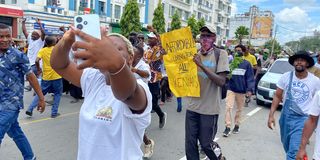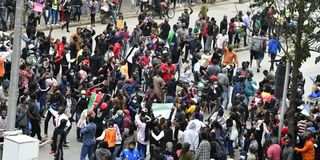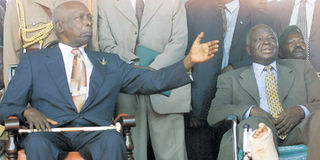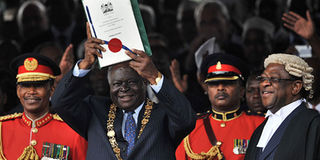Premium
Why current protests should not be seen as an isolated surprising event

So far, the anti-government protests in Mombasa CBD have been peaceful.
Kenya has, for the last three weeks, faced nationwide protests, mainly led by young people, who are famously known as Generation Z (born between 1997 and 2012).
They were initially mostly against the taxation proposals contained in the now-rejected Finance Bill 2024 in which the government, with support from the International Monetary Fund (IMF), sought to raise an additional Sh323 billion for the next financial year.
The youths in over 39 counties mobilised under the banners ‘Occupy Parliament’ and ‘Reject Finance Bill.’ They were confronted with tear gas and water cannons. Police arrested dozens of them too. This mobilisation that was aided by social media had been largely peaceful but turned deadly on June 25 with at least 13 people being killed that day.
So far, 39 people have lost their lives and dozens others injured in connection to the protests, according to the Kenya National Human Rights Commission. Rights watchdogs have mainly blamed the police for the deaths including use of live fire on unarmed protesters.

Anti-riot policemen advance on a group of protesters in Mtwapa on July 2, 2024.
Economic analysts have strongly linked the protests to financial grievances around the proposed taxes that they say are caused by slow economic growth that in turn causes unemployment, reduced income levels, decreased investments and an overall low standard of living.
History of failed institutions
It, however, has deeper roots than this and mirrors the sentiments of many Kenyans since independence. In fact, the protests were simply a trigger of monstrous challenges that have faced Kenya for a long time now.
This is something that partly explains the continuation of the protests despite the withdrawal of the proposed finance bill. It is therefore mainly about failed institutions and lack of accountability. It is ‘that middle finger’ attitude that has been displayed to Kenyans by politicians for far too long.
In 1991, Kenya turned a page after repealing Section 2A of the then Constitution to allow multiparty politics.
The government had finally cracked from external pressure to open up political spaces. But it did not stop undemocratic practices, impunity and violence by the then president Daniel Moi and his cronies, especially during election circles.
As a result, calls for equality through constitutional amendment became the rallying call from the opposition and members of the civil society.

Hundreds of youths converge at the junction of Kenyatta Avenue and Moi Avenue during the Occupy Parliament protests in Nairobi on June 20, 2024.
Moi was eventually pushed out of office by a united ‘unbwogable’ opposition under the umbrella of the National Rainbow Coalition (Narc) in 2002 that promised an all-round political and socio-economic reform.
Narc was committed to distinguishing itself from the previous regime and so, true to its word, positive economic changes were recorded. They included the much-applauded free primary education and the rolling out of the Constituency Development Fund (CDF) which helped address the problem of the executive rewarding cronies or punishing political enemies.
The CDF and other funds were, however, faced with huddles when resources started being misused and participation of constituents was limited by some who were less committed to decentralisation.
Political differences between coalition partners nepotism and corruption were also rampant under Narc that culminated in the 2007/8 political violence triggered by allegations of vote rigging.
Calm of commissions of inquiry before a storm
Calm would later return following external mediation efforts, a coalition government and three commissions to address the root causes of the violence and make recommendations. T
These included the Independent Review Commission (Irec) or the Kriegler Commission (to investigate the violence and to recommend preventive measures), the Commission of Inquiry into the post-election violence or the Waki Commission) and the Truth, Justice and Reconciliation Commission (TJRC) to inquire into historical injustices and oversee reconciliation.
In this context, the stalled constitutional review process was revived and in 2010, Kenya promulgated a new constitution. This was a triumphant moment filled with anticipation for better times to come especially with the introduction of a devolved system. The county was united in optimism.

Former President Daniel Moi (left) when he handed over power to Mwai Kibaki at Uhuru Park in Nairobi, on December 31, 2002.
However, soon after, challenges around insufficient resource allocation and delayed disbursement, insufficient public participation, political interference, nepotism and exclusion of minorities at the county level emerged.
Outcomes of the commissions of inquiry also remained largely unimplemented. This meant that peace remained fragile, especially with the backward trend in democratic gains under the Jubilee administration that in its first term (2013) was the most corrupt in Kenya’s history.
Impunity and a frustrated public
The persistence of malpractices even with the new constitution pushed Kenyans to lose hope in demanding more as was the case in the 1990s.
This was particularly evident with the evasion of justice by the president and his deputy – two wanted suspects by the International Criminal Court (ICC) not to mention the disappearance of witnesses in their cases.
Failed promises, lack of reforms of the Independent Electoral and Boundaries Commission (IEBC) and the ‘middle finger attitude of: ‘we have managed to evade the ICC and will go for two 5-year terms each’ bred a sense of hopelessness amongst Kenyans who are interested in genuine reforms.
The surprise handshake between the opposition (the figure of Raila Odinga) and his rival, President Uhuru Kenyatta further left Kenyans confused and largely on their own, in the face of institutional hijacking (including the clergy and the clumping down of civil society) despite hardships including the heavy burden of corruption and debt.
Negative peace, less accountability
President William Ruto’s current regime uses enforced taxation as a strategy for increasing revenue, something that has outraged the public given the high cost of living and lack of opportunities that should be the basis for such taxes.

President Kibaki (second left) lifts up Kenya's new Constitution soon after promulgating it at Uhuru Park, Nairobi August 27, 2010.
This stands in contrast to the extravagant lifestyle of public officials in his regime and lack of proper plan to cut expenditure.
The proposal to further increase taxes as contained in the Finance Bill 2024 therefore caught an already fatigued population that had already reached its maximum pressure point and so it was the last trigger in a long and abusive relationship by the State against its citizens.
Negative peace has been ubiquitous in Kenya throughout its history and so the eruption of the recent protests is not a surprise.
Armed groups, criminal gangs, secessionist attempts and even the participation of Kenyan citizens in al-Shabaab against their own country is a strong indication of an exclusive and suppressive system.
Violent actions of the police is another indication of undemocratic tendencies that only provokes more escalation.
There are enough lessons across the globe that demonstrate how, whenever exclusion and suppression thrive, radicalisation of movements is also likely to take place that can push for
clandestinely when legitimate means of contention become ineffective.
This is perhaps less likely to happen with the current Gen Z protests but it has already happened with the experience of Kenyans in al-Shabaab.
Continual bad deeds
Therefore, just like the 2007/8 political violence, the current protests should not be seen as an isolated surprising event but as part of a large pattern that occurs as a result of captured institutions, exclusive political processes that lack accountability and which promote suppressive tactics to silence critics.
The escalation of the protests should therefore be an opportunity to review policy priorities as opposed to only a rejection of the bill by the president. Work should begin with active listening and implementation of reports that are gathering dust on shelves such as that of the TJRC.
The other more costly option is to look the other way and wait for the next ‘surprise’ eruption of protest or violence in case there will be a next time.
##
Dr Hawa Noor is an associate of the Institute for Intercultural and International Studies (InIIS) at the University of Bremen. She is the author of ‘Mobilization for Violent Politicized Islam - Motivations of Former Participants in al-Shabaab’ (2024). [email protected]





